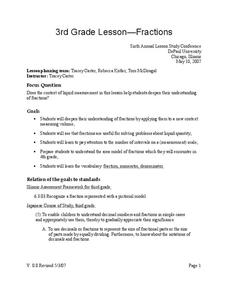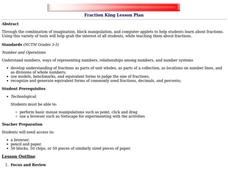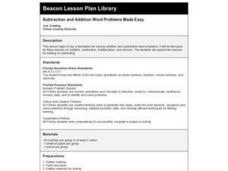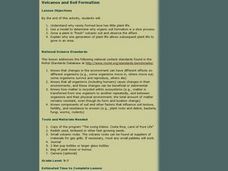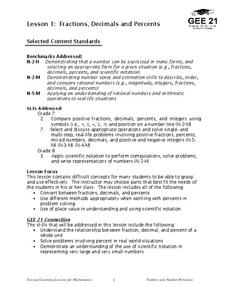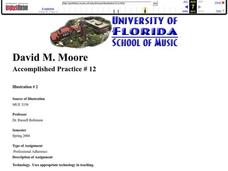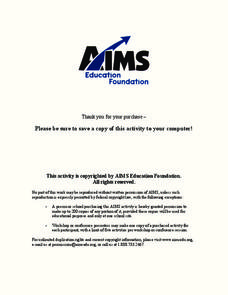Curated OER
Animal Classifications
Third graders work in small groups to investigate how to sort a variety of items into groups and subgroups. They work on a class chart based on the activity which show how the items are classified based on commonalities. Upon completion...
Curated OER
Fractions
Students practice measurement. In this fractions instructional activity, 6th graders measure volume of a liquid, e.g. 1/5 liter, and learn the vocabulary of fractions (numerator, denominator). Students solve sample problems...
Curated OER
Fraction King Lesson Plan
Young scholars examine the concept of fractions. In this fractions king lesson, students review math vocabulary and discover the equivalent forms of fractions as decimals and percents.
Curated OER
Millie's Math House Lesson Plan
Students count, match and arrange unordered fixed objects. Millie's Math House Cookie Factory educational software is used in this lesson.
Curated OER
Subtraction and Addition Word Problems Made Easy
Third graders create addition and subtraction word problems for a partner to solve using marbles. They explain whether the problem is an addition, subtraction, "take away", "have and need", compare or "what is the rest" type problem.
Curated OER
The Carbon Cycle
Fifth graders examine the carbon cycle, periodic table, and photosynthesis and respiration. They analyze the periodic table and how it is organized, then complete the "Elementary, Dear Watson" worksheet. Students then examine a carbon...
Curated OER
Great Tasting Shapes
Fifth graders investigate the concept of median, mode, and range using a simple model for display purposes. They examine different shaped crackers out of a box and identify the ones that occur the most. Then the calculations for the...
Curated OER
Using Inequalities to Problem Solve
Learners explore inequalities. In this Algebra I lesson, students solve and graph linear inequalities involving addition, subtraction, multiplication, or division. Learners use inequalities to solve and graph real-world problems.
Curated OER
Why So Many Frogs?
Students explain the different stages in the growth of a frog, then analyze and collect data to make generalizations about a larger population. They determine the survival rate of a population of tadpoles under controlled conditions.
Curated OER
Sum of the Parts
Fifth graders build objects using various materials. They estimate the weight of the object using individual building pieces. Then they weigh the actual object and then tear it apart and weigh the pieces. They compare the two weights.
Curated OER
Opinion Surveys
Students examine the factors that affect the accuracy of opinion surveys. They calculate probability and chance using data they have collected. They practice reading tables and graphs as well.
Curated OER
Function Tables
Students practice representing problems found in the real world in terms that can be translated into mathematical expressions. The situations are represented in tables and graphs by students.
Curated OER
Understanding Radios
Fifth graders explore ratios. Using models and real-world scenarios, they complete tables and generate comparisons. Pupils demonstrate multiple ways of writing ratios and describe the differences between ratios.
Curated OER
Magnets 2: How Strong is Your Magnet?
Pupils work together to test the strengths of various types of magnets. After testing, they create a graph showing how the strength changes as the distance from the magnet increases. They discuss how forces can act from various...
Curated OER
Science: The Bicycle as a System
Students explore how the different parts of a bicycle relate to each other and identify the subsystems. They discover how bicycles work and investigate their history. In groups, students research each of the subsystems and present...
Curated OER
Fractions, Decimals, and Percents
Learners connect different mathematical concepts. They create a circle graph. Students then create a question in which they collect data in order to convert fractions to decimals and decimals to percents.
Curated OER
Music and Technology
Third graders practice reading rhythm patterns with different types of notes and meters. Using a counting system, they perform a sight reading exercise and take notes when needed. They use a form of technology to illustrate the music.
Curated OER
The 3R's: Rights, Rules, and Responsibilities
Eighth graders complete seven work stations that highlight math activities while they focus on the rules for Internet use and classroom rules for working in cooperative groups. After completing the activities, they complete a self-...
Curated OER
Farm Animals
First graders use this Web Quest to find out about 6 different farm animals. They explore what each animal eats and what food humans get from each animal. They study about are pigs, sheep, goats, horses, cows, and chickens.
Curated OER
Balanced Or Unbalanced
Students use physical models and graphs in order to solve problems that have their origin in the real world that require algebraic thinking. The words are changed into equations and inequalities in order to be solved. This requires...
Curated OER
Periodic Trends
Students explore the rationale behind the arrangement of the elements on the Periodic Table. Using internet and traditional research, students compare and contrast the properties of elements on the periodic table to determine a...
Curated OER
Resources and Trade Flow
Students plan for a service project. In this service lesson, students determine the materials they will need to complete their service project. Students discuss possible trade flows into the United States.
Curated OER
By Golly, By Gum
Students investigate the ingredients and creation of chewing gum. In this scientific method lesson, students make predictions about what will happen to the mass of a piece of gum as it is chewed by a human. Students graph the...

